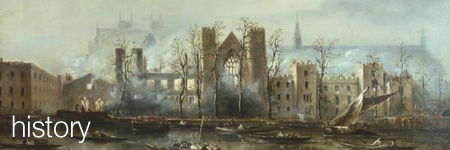
La Belle Sauvage
Ludgate Hill (EC3) Stow mentions a Mrs. Savage as having given the inn to the Cutlers' Company, which, however, the books of that Company disprove. This, anyhow, is certain, that in 1568 a John Craythorne gave the reversion of the "Belle Sauvage" to the Cutlers' Company, on condition that two exhibitions to the University and certain sums to poor prisoners be paid by them out of the estate. In 1648 and 1672 the landlords' tokens exhibited an Indian woman holding a bow and arrow. The sign in Queen Anne's time was a savage man standing by a bell. The question therefore is, whether the name of the inn was originally derived from Isabel (Bel) Savage, the landlady, or the sign of the Bell and Savage; or whether it was, as the Spectator cleverly suggests, from La Belle Sauvage, "the beautiful savage," which derivation is very generally received. (Reference: Thornbury's Old and New London, vol. I, p. 221) In Bell Savage Yard lived Grinling Gibbons. Here Sir Thomas Wyatt's rebellion was stopped. (Reference: Timbs's Curiosities of London, p. 539)